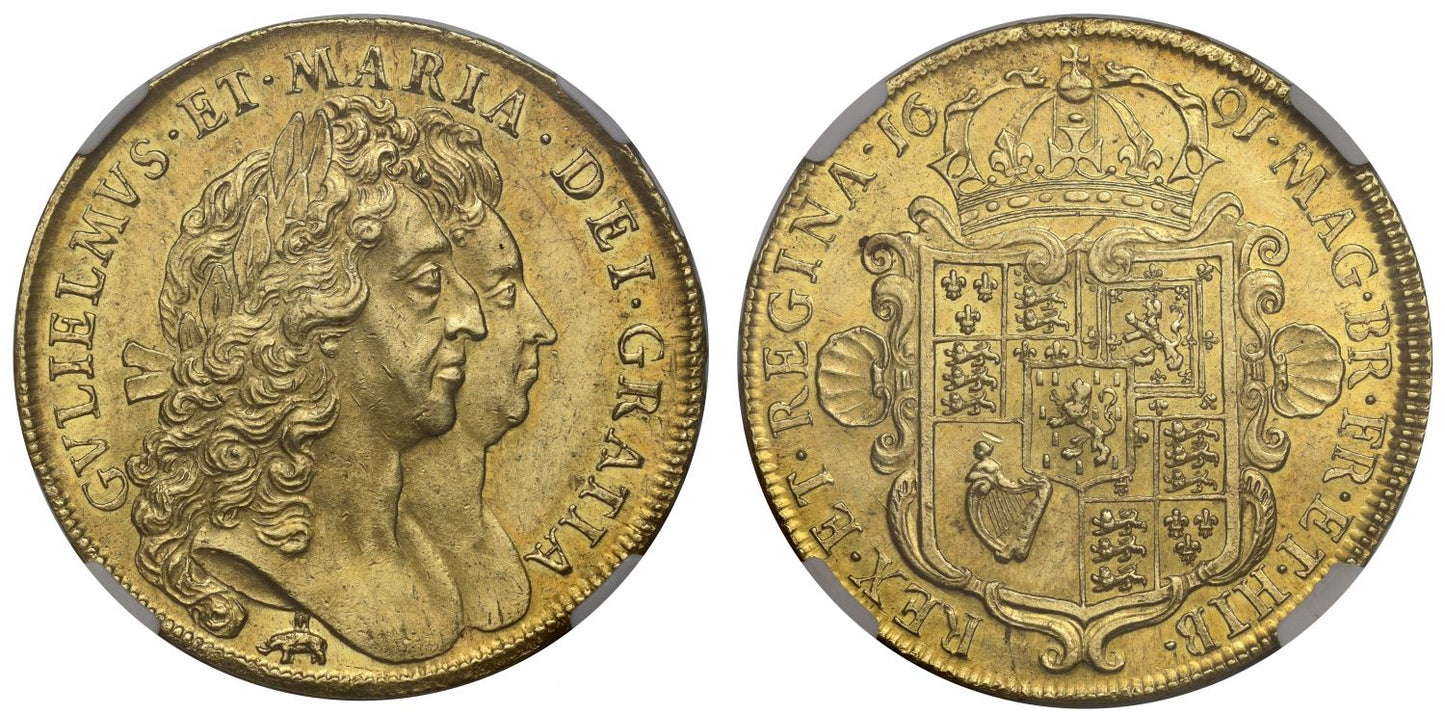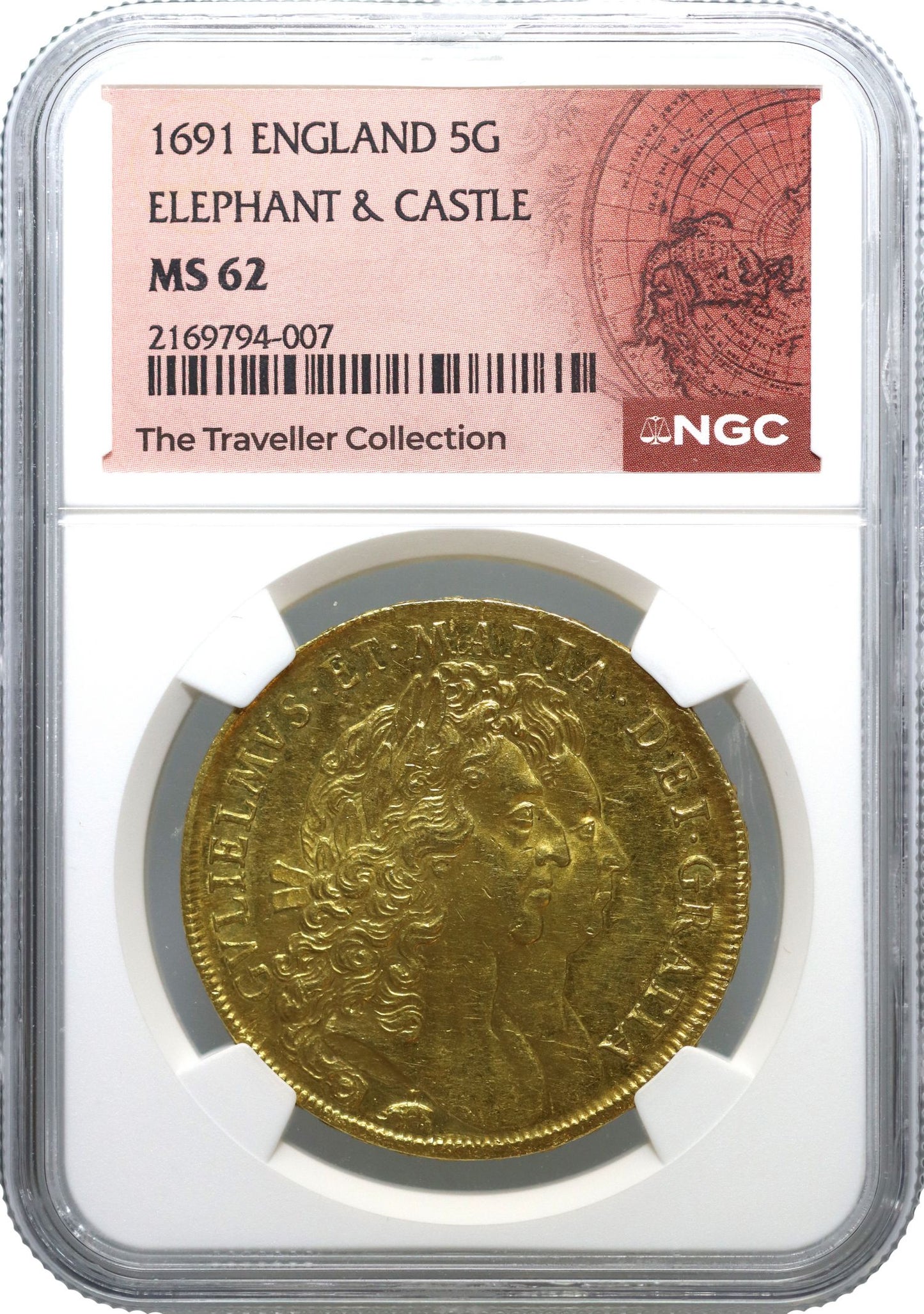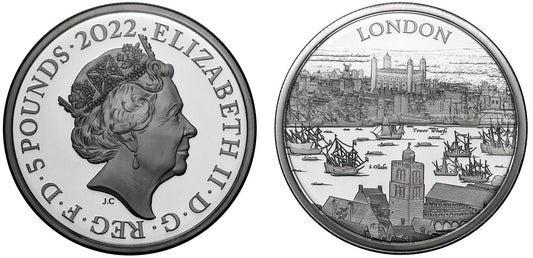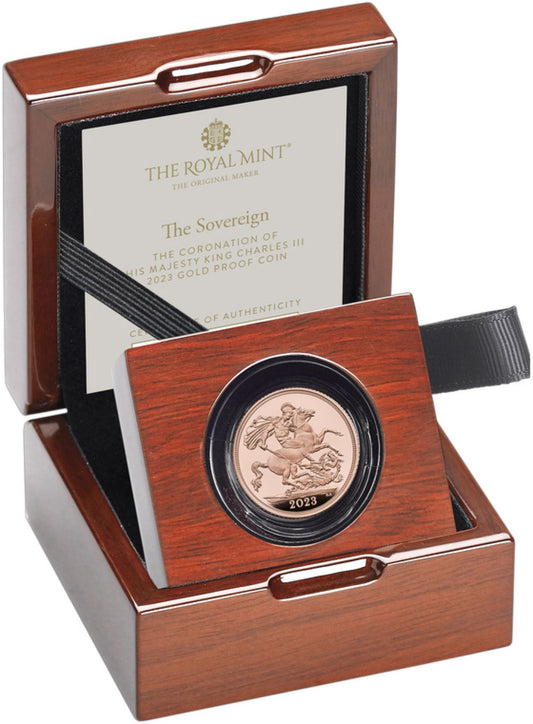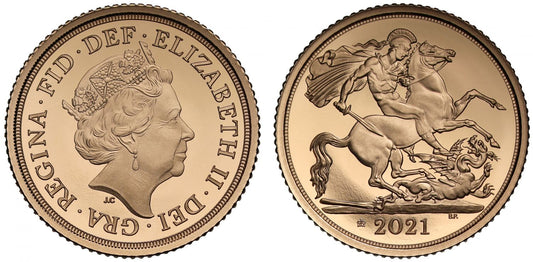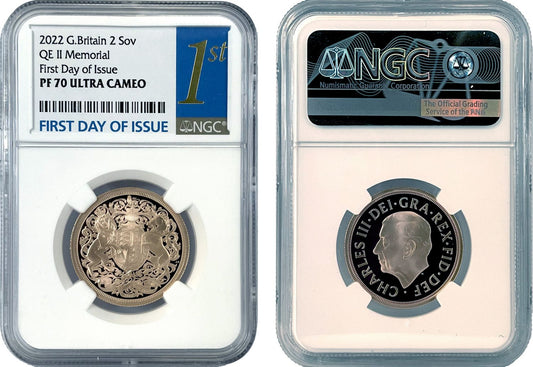FAQs
What makes a coin valuable?
I have coins to sell, what’s the next step?
How will my purchases be shipped?
What happens if I’m not entirely happy with my purchase?
William and Mary 1691 Five-Guineas Elephant & Castle NGC MS62 finest graded
William and Mary (1688-94), gold Five Guineas, 1691, elephant and castle below, conjoined laureate busts right, Latin legend with pellet stops surrounding, GVLIELMVS. ET. MARIA. DEI. GRATIA toothed border surrounding, rev. crowned quartered shield of arms with scalloped frame, with an escutcheon of the Lion of Nassau, 8 strings to Irish harp, date either side of top crown, abbreviated Latin legend .MAG. BR. FR. ET.HIB REX. ET. REGINA. toothed border surrounding, edge inscribed in raised letters DECVS ET TVTAMEN ANNO REGNI TERTIO (Schneider 461; Bull EGC 345; King -; Holloway 48; M.C.E. 137; Traveller 2030 this coin; S.3423). Toned with a light red hue and underlying brilliance, with some nicks and hairline marks, black spot on upper left of shield, has been slabbed and graded by NGC as MS62 with special provenance label, the finest graded at NGC.
NGC Certification 2169794-007 - as of June 2025 this is the finest graded example at NGC of the elephant and castle variety for this date out of 19 graded and is far superior to the five examples graded by PCGS.
King Survey = 70 examples in commerce over the period 1960-2005, this coin is an addition.
The Latin legends translate as on the obverse "William and Mary by the Grace of God," and abbreviated on the reverse as "King and Queen of Great Britain, France and Ireland."
James and Norbert Roettier, the sons of John who was about to retire to Brussels, were the engravers of the coinage and expected to take over his position as Chief(s), however perhaps because they were Roman Catholic, the position of Chief went to George Bowers at Michaelmas 1689, but he later died on 1st March 1690. As the Chief position then went to the Engraver of Seals, Henry Harris, and as he did not have coin die work experience he arranged for the Roettier brothers to work on the coin dies right through till 1697 whereupon a similar arrangement was taken up with John Croker.
For 1691 gold output was the second lowest of this joint reign at £54,497 for the calendar year across all the denominations, the highest output being in 1689 at £128,442 worth and the lowest in 1690 at £48,772. This coin is struck from gold supplied by the Royal African Company of England which is defined by the elephant and castle provenance mark below the bust. The company had been so reconstructed by the Duke of York from 1672. The "R.A.C." was quite a success trading with Africa and the New World through the 1670s and 1680s, and 1691 was the last good year before troubles started again from 1692, what with the nine years war with France and competition to their African monopoly. For further reading see "The Metal in Britain's Coins" by Graham Birch. We also note an account of the number of guineas coined out of the Royal African Company gold appeared in the Gazetteer and London Daily Advertiser of the 23rd January 1755 which was reproduced in Thomas Snellings publication of 1763. This account tells us that 26,700 Guineas (£29,296worth) were struck presumably out of the £54,497 worth of goldwhich leaves £25,201 to have been struck into all the other denominations of gold. For 1691 there were all four denominations issued for the Royal African Company as well as Five Guineas, Guineas and Half-Guineas from other sources of gold. Therefore, it would seem the lion's share of gold this calendar year came originally from Africa.Provenance Story:
This coin has a most intriguing provenance being hidden away in a European family collection since before World War II. The "Traveller" was a wealthy gentleman who having inherited a portion of a successful family company, made a fortune by promptly selling it and then travelled the world on what was in part an extended honeymoon for the decade between the Wall Street Crash of 1929 and the outbreak of World War II. With the financial instability of the great depression and after dabbling at first with gold bullion, he decided to form an enormous collection of world gold coins from ancient to modern whilst travelling the world to see the relevant dealers in their geographical locations to find the most appropriate coins. The result was a collection of some 15,000 coins, 1,700 of which we are told are British, with all going into secure hiding as of 1940 when the nazi regime encroached on where our traveller was located. Sadly, the collector died of a stroke with the stress of the world situation at this time and the collection remained hidden away for decades, stored carefully in individual envelopes in cigar boxes within locked aluminium strongboxes, that were buried in the ground in a field at the collector's property. His wife carried the secret of the burial location for the decades following and reaching the end of her life some 50 years later divulged the secret to her only daughter, whereupon in the 1990s the family retrieved all the coins intact and secured them safely in a bank vault until it was time to sell by auction in 2025. Though we often hear of buried treasure or hoards of coins from antiquity in the ground, it is not often we hear of a sophisticated coin collection actually being buried for decades, an intriguing story to permanently associate with coins of the Traveller provenance which has been written about in newspapers and online worldwide. We are lucky enough to have secured a small number of rare British coins from this esteemed collection.
We note the Traveller obtained this coin from another large collection that of Thomas Bryan Clarke-Thornhill (1857-1934) who owned over 10,000 coins of the World in varying metals and worked in the diplomatic service but lived on independent wealth in London joining the British Numismatic Society in 1912. When he died the British Museum was given first choice from the collection for potential upgrades and filling of any gaps in the national collection and they selected over 6,000 pieces with the rest being sold. The auction of 1937 contained 936 lots of British and foreign coins and is always a good mark of quality.
Provenance:
Ex T. Bryan Clarke-Thornhill, first portion, Glendining, 24th May 1937, lot 227, sold for £33/10/-.
Ex The Traveller Collection.
FAQs
What makes a coin valuable?
I have coins to sell, what’s the next step?
How will my purchases be shipped?
What happens if I’m not entirely happy with my purchase?
